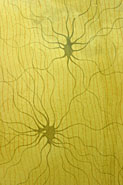Foundations: Nervy art
Architect shows brains at the MNI
  Lobby ceiling (details)
Lobby ceiling (details)Photos: Owen Egan |
|
Artists and architects often look to nature for inspiration, painting murals of landscapes, fashioning latticework to look like tree boughs. But how many ceilings boast golden nerve cells?
Walk right into the lobby of the Montreal Neurological Institute (MNI) at 3801 University, look up at the ceiling and think of Klimt. The golden glow of the room is 19th-century Austria, but as you examine the curious curlicue shapes, notice they aren't random decorative squiggles, but that the inspiration for the design lies deep within the human brain.
The art deco-style entrance was designed by MNI founder Wilder Penfield and architect Barnet Phillips in 1934.
Even from the street you can see the marble statue of Nature unveiling herself before science, carved by Aldophe Galli for Penfield. The original, by Louis-Ernst Barrias, is in the Musée National d'Art Modern in France.
The ceiling shows three of the six layers of the cerebellum, after a drawing by neurologist Camillo Golgi (1843-1926). Sprawling silver cells, rounded disk nerve cells, and filigree blood vessels dance across the gold ceiling. In the centre, a ram's head represents Aries, the astrological sign that presides over the brain. Four hieroglyphic figures from a 3000 BC papyrus surround the ram, believed to be the first written representation of the word for brain. The ceiling's border is a repeated pattern of the cerebellum's fluid-filled cavities.
The anatomical art doesn't stops at the walls. The gratings on the radiator are based on a drawing of nerve fibre -- axon and sheath -- by French neuroanatomist Jean Nageotte (1866-1948). The inlay wood tabletop in front of the statue depicts a cross-section of the brain's hemispheres. Look at the lamp stands. Remind you of the spinal cord, perhaps?
 MNI lobby
MNI lobby |
|
While you're there, trot down the hallway from the lobby to see a lovely statue of Peter Pan (the original's in Kensington Gardens) dedicated to the children of the MNI in memory of Dr. William Vernon Cone.
But one of McGill's best brain oddities isn't in the room. Go outside onto University, head north up the hill. Turn the corner of the building and behold a bas-relief of a brain composed of writhing toddlers.
 |
|
Affectionately known as the "brain babies," there's a copy inside on the 6th floor. Dr. William Feindel (MNI director, 1972-1984) informed the Reporter that Penfield received a 1929 Christmas/New Year's card of the brain babies from Dr. Ariens Kappers, director of the Brain Research Institute in Amsterdam. Feindel wrote, "The Neuro artist at that time, on Dr. Penfield's suggestion, re-drew the babies to match the actual pattern of motor and sensory function on the brain surface as defined by electrical 'brain mapping.' Then came the sculpting, modelled on Hortense Cantlie's re-drawing." The sculpture of the squirmy homunculi was used for the McConnell Pavilion plaque, dedicated by Governor-General Vincent Massey in 1953.

